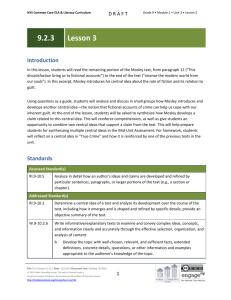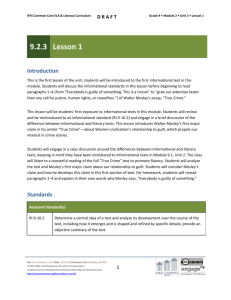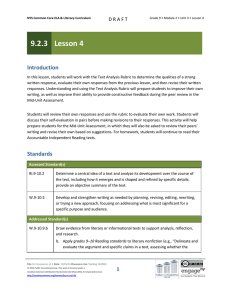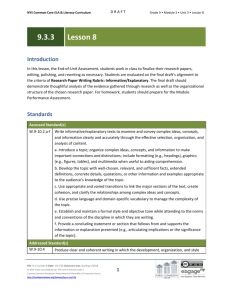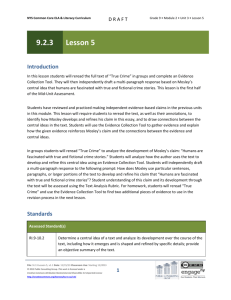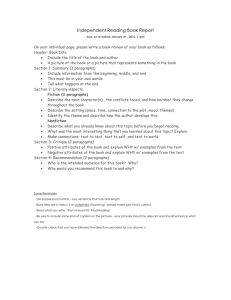124.82 KB - EngageNY
advertisement
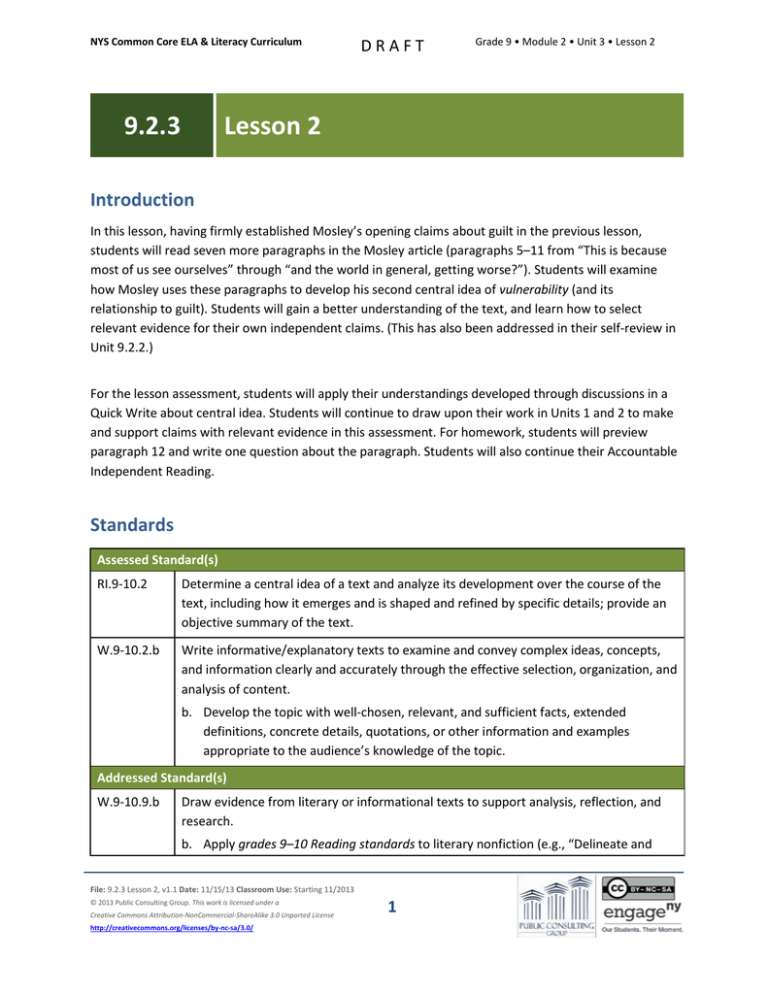
NYS Common Core ELA & Literacy Curriculum 9.2.3 DRAFT Grade 9 • Module 2 • Unit 3 • Lesson 2 Lesson 2 Introduction In this lesson, having firmly established Mosley’s opening claims about guilt in the previous lesson, students will read seven more paragraphs in the Mosley article (paragraphs 5–11 from “This is because most of us see ourselves” through “and the world in general, getting worse?”). Students will examine how Mosley uses these paragraphs to develop his second central idea of vulnerability (and its relationship to guilt). Students will gain a better understanding of the text, and learn how to select relevant evidence for their own independent claims. (This has also been addressed in their self-review in Unit 9.2.2.) For the lesson assessment, students will apply their understandings developed through discussions in a Quick Write about central idea. Students will continue to draw upon their work in Units 1 and 2 to make and support claims with relevant evidence in this assessment. For homework, students will preview paragraph 12 and write one question about the paragraph. Students will also continue their Accountable Independent Reading. Standards Assessed Standard(s) RI.9-10.2 Determine a central idea of a text and analyze its development over the course of the text, including how it emerges and is shaped and refined by specific details; provide an objective summary of the text. W.9-10.2.b Write informative/explanatory texts to examine and convey complex ideas, concepts, and information clearly and accurately through the effective selection, organization, and analysis of content. b. Develop the topic with well-chosen, relevant, and sufficient facts, extended definitions, concrete details, quotations, or other information and examples appropriate to the audience’s knowledge of the topic. Addressed Standard(s) W.9-10.9.b Draw evidence from literary or informational texts to support analysis, reflection, and research. b. Apply grades 9–10 Reading standards to literary nonfiction (e.g., “Delineate and File: 9.2.3 Lesson 2, v1.1 Date: 11/15/13 Classroom Use: Starting 11/2013 © 2013 Public Consulting Group. This work is licensed under a Creative Commons Attribution-NonCommercial-ShareAlike 3.0 Unported License http://creativecommons.org/licenses/by-nc-sa/3.0/ 1 NYS Common Core ELA & Literacy Curriculum DRAFT Grade 9 • Module 2 • Unit 3 • Lesson 2 evaluate the argument and specific claims in a text, assessing whether the reasoning is valid and the evidence is relevant and sufficient; identify false statements and fallacious reasoning”). L.9-10.4.a Determine or clarify the meaning of unknown and multiple-meaning words and phrases based on grades 9–10 reading and content, choosing flexibly from a range of strategies. a. Use context (e.g., the overall meaning of a sentence, paragraph, or text; a word’s position or function in a sentence) as a clue to the meaning of a word or phrase. Assessment Assessment(s) The learning in this lesson will be captured through a Quick Write at the end of the lesson. Students will answer the following prompt based on the close reading (citing text evidence and analyzing key words and phrases) completed in the lesson: What details does Mosley use to develop a central idea in paragraphs 5–11? High Performance Response(s) A High Performance Response may include the following: Mosley defines a central idea of vulnerability in these paragraphs. He describes it as the feeling we all have that we are “potential victims” in a “crossfire between the forces of so-called good and evil.” Mosley continues to develop this idea of vulnerability in society by questioning whether it is safe to do something as simple as “walk the streets” or “speak to an attractive stranger.” Another reason we feel vulnerable, according to Mosley, is that we do not understand why “the economy, and the world in general, [are] getting worse.” Vocabulary Vocabulary to provide directly (will not include extended instruction) vengeance (n.) – punishment inflicted or retribution enacted for an injury or wrong urban dweller (n.) – someone who lives in a city misinform (v.) – to give false or inaccurate information impartial (adj.) – objective; fair and just Vocabulary to teach (may include direct word work and/or questions) vulnerability (n.) – the state of being susceptible to physical or emotional attack or harm objective (adj.) – not influenced by feelings or opinions File: 9.2.3 Lesson 2, v1.1 Date: 11/15/13 Classroom Use: Starting 11/2013 © 2013 Public Consulting Group. This work is licensed under a Creative Commons Attribution-NonCommercial-ShareAlike 3.0 Unported License http://creativecommons.org/licenses/by-nc-sa/3.0/ 2 NYS Common Core ELA & Literacy Curriculum DRAFT Grade 9 • Module 2 • Unit 3 • Lesson 2 Lesson Agenda/Overview Student-Facing Agenda % of Lesson Standards & Text Standards: RI.9-10.2, W.9-10.2.b, W.9-10.9.b, L.9-10.4.a Text: “True Crime,” paragraphs 5–11 Learning Sequence 1. 2. 3. 4. 5. 6. 7. 1. 2. 3. 4. 5. 6. 7. Introduction to Lesson Agenda Homework Accountability Opening Activity Paragraphs 5–11 Reading and Discussion Relevant Evidence Mini Lesson Quick Write Closing Materials Student copies of the Short Response Checklist and Rubric (refer to 9.2.1 Lesson 1) Learning Sequence How to Use the Learning Sequence Symbol 10% Type of Text & Interpretation of the Symbol Percentage indicates the percentage of lesson time each activity should take. Plain text (no symbol) indicates teacher action. Bold text (no symbol) indicates questions for the teacher to ask students. Italicized text (no symbol) indicates a vocabulary word. Indicates student action(s). Indicates possible student response(s) to teacher questions. Indicates instructional notes for the teacher. File: 9.2.3 Lesson 2, v1.1 Date: 11/15/13 Classroom Use: Starting 11/2013 © 2013 Public Consulting Group. This work is licensed under a Creative Commons Attribution-NonCommercial-ShareAlike 3.0 Unported License http://creativecommons.org/licenses/by-nc-sa/3.0/ 3 5% 15% 10% 30% 15% 20% 5% NYS Common Core ELA & Literacy Curriculum DRAFT Grade 9 • Module 2 • Unit 3 • Lesson 2 Activity 1: Introduction to Lesson Agenda 5% Begin by reviewing the agenda and assessed standard for this lesson: RI.9-10.2. In this lesson, students will continue to explore Mosley’s development of his second central idea about our relationship to guilt. Inform students that they will also review how to select relevant evidence to support their claims. Students look at the agenda. Activity 2: Homework Accountability 15% Instruct students to pair up and share the results of the research they conducted for homework on one of the historical references from paragraph one. Ask pairs to consider how what they learned relates to Mosley’s essay. Students discuss how their research relates to Mosley’s essay and then hand in their homework. Instruct students to talk in pairs about how they can apply their focus standard to their text. Lead a brief share out on the previous lesson’s AIR homework assignment. Select several students (or student pairs) to explain how they applied their focus standard to their AIR text. Students (or student pairs) discuss and share how they applied their focus standard to their AIR text from the previous lesson’s homework. Activity 3: Opening Activity 10% Instruct students to respond to the following question, in writing: In your own words explain why Mosley says, “Everybody is guilty of something.” Instruct students to discuss their answer in pairs once they have written a response. Students respond to the prompt and discuss their answers in pairs. This opening activity, which can be a discussion question instead of a Quick Write at the teacher's discretion, encourages students to maintain a focus on the central ideas and claims made by the author, while allowing space for synthesis by having the students articulate their response in their own words. This will also give the teacher an additional opportunity to informally assess for student understanding of the text. If the opening activity is structured as a discussion, consider reviewing applicable discussion protocols to reinforce student understanding of speaking and listening expectations established in Module 9.1 and in Units 1 and 2 of this module. File: 9.2.3 Lesson 2, v1.1 Date: 11/15/13 Classroom Use: Starting 11/2013 © 2013 Public Consulting Group. This work is licensed under a Creative Commons Attribution-NonCommercial-ShareAlike 3.0 Unported License http://creativecommons.org/licenses/by-nc-sa/3.0/ 4 NYS Common Core ELA & Literacy Curriculum DRAFT Grade 9 • Module 2 • Unit 3 • Lesson 2 Activity 4: Paragraphs 5–11 Reading and Discussion 30% Introduce the Quick Write assessment (What details does Mosley use to develop a central idea in paragraphs 5–11?). Explain to students that this is the lesson assessment and the focus for today's reading. Students read the assessment and listen. Display the Quick Write assessment for students to see. Instruct students to form pairs and read paragraphs 5–7 from “This is because most of us see ourselves” through “the words of political, religious, corporate, and social leaders?” Then direct pairs to discuss the following questions and record their answers in writing. What is Mosley referring to by “This” when he writes, “This is because most of us see ourselves as powerless cogs in a greater machine”? “This” refers to Mosley’s preceding comment about our interest in “true-crime stories, murder mysteries,” etc. rather than an interest in “justice” and “human rights” What images in paragraph 5 could help you determine the meaning of vulnerability in paragraph 6? What does vulnerability mean? The images of cogs in a machine, innocent bystanders, potential victims, caught in crossfire describe humans in a weak state. Vulnerability is “the state of being open to harm or attack.” Consider drawing students’ attention to their application of standard L.9-10.4.a through the process of determining word meaning through the use of context clues. Why would someone “feel stupid for doing what they were taught was right”? How this does relate to our vulnerability? Someone would feel stupid for doing what they thought was right if that was going to get them killed, and Mosley is saying that we see this happen on TV so perhaps it could happen to us. This uncertainty makes us feel vulnerable, or unsafe. Lead a brief class discussion of these questions. Remind students to take notes during the discussion. Instruct student pairs to continue reading “True Crime,” paragraphs 8–11 from “In smaller societies we worked side by side” through “and the world in general, getting worse?” Then direct pairs to discuss their responses to the following questions before recording them in writing. Explain Mosley’s claim about life in “smaller societies.” What is different today? File: 9.2.3 Lesson 2, v1.1 Date: 11/15/13 Classroom Use: Starting 11/2013 © 2013 Public Consulting Group. This work is licensed under a Creative Commons Attribution-NonCommercial-ShareAlike 3.0 Unported License http://creativecommons.org/licenses/by-nc-sa/3.0/ 5 NYS Common Core ELA & Literacy Curriculum DRAFT Grade 9 • Module 2 • Unit 3 • Lesson 2 Mosley says that in smaller societies we “worked side by side with leaders” and had “face-toface meetings,” which “gave us at least the illusion of understanding where we stood and what was right.” He means that we used to get our information right from the actual people making decisions, but today, the “urban dweller” gets information from “TV and computer screens,” and the people in the news often “misinform.” Remind students to use the vocabulary from the text in their responses to practice use as well as reinforce meaning. If necessary, offer students a definition of urban dweller as “someone who lives in a city.” What does Mosley mean by “the illusion of understanding”? Mosley means that even if we didn’t understand “where we stood and what was right,” it felt like we did, because we had face-to-face contact. What does Mosley mean by “the media misinform”? He is saying that no information we get is completely reliable. If students struggle with the meaning of misinform, help them elicit meaning from context, by highlighting the contrast between smaller societies’ methods of gathering and distributing information and the typical urban dweller’s consumption of information. Mosley implies that the former is more reliable; therefore the latter would be less reliable. Since the media outlets are sources that have a lot more filters and require more analysis, the “urban dweller” needs to be both critical and literate. Why might we distrust an “objective opinion source”? Because opinions cannot be objective—they are beliefs. Provide students with the definition of objective as “not influenced by feelings or opinions.” How does the author connect vulnerability to guilt in paragraphs 5–11? Mosley says that society, which often makes us feel guilty of things beyond our control, also makes us feel very vulnerable because we are so small and it is so big and “insensitive.” Mosley also asks if we would be “guilty of being stupid” if we turned someone in for murder. If we cannot trust what we “were taught was right” we feel exceptionally vulnerable. Lead a brief class discussion of these questions. Remind students to take notes during the discussion. Instruct students to review their responses to the previous question and annotate the text for evidence of the development of a new central idea. Students should write the code CI in the margin. Remind students that as they annotate for central idea, they are beginning to identify textual evidence that may be used in the lesson assessment as well as the Mid-Unit and End-of-Unit Assessments, which address File: 9.2.3 Lesson 2, v1.1 Date: 11/15/13 Classroom Use: Starting 11/2013 © 2013 Public Consulting Group. This work is licensed under a Creative Commons Attribution-NonCommercial-ShareAlike 3.0 Unported License http://creativecommons.org/licenses/by-nc-sa/3.0/ 6 NYS Common Core ELA & Literacy Curriculum DRAFT Grade 9 • Module 2 • Unit 3 • Lesson 2 the development of central ideas in the text. This focused annotation supports students’ engagement with W.9-10.9.b, as they draw evidence from the text to use in their writing. Students may identify and annotate for two central ideas in the text: guilt and vulnerability. As students begin to track the development of multiple central ideas in the text, instruct students to distinguish between the ideas by adding vulnerability or guilt to the code CI in the margins. Activity 5: Relevant Evidence Mini Lesson 15% Remind students that selecting relevant evidence to support their claim is an important part of writing and will be a part of their Mid-Unit Assessment. Relevant evidence refers to the facts or quotes from the text that most effectively support a claim or develop a response. Selecting relevant evidence is a skill included in W.9-10.2.b, one of the assessed standards for this lesson. Provide the statement, “Mosley claims that everyone is guilty of something,” and ask students to locate two pieces of relevant evidence that supports this claim. Students review the text and their annotations to locate evidence in support of this claim. Student responses may include: o o o “It goes all the way back to Cain and original sin and has been a central topic of discourse among members of society.” “We have also been guilty of our religion, national origin, skin color...and, now and then, of the blood in our veins.” "Guilt is the mainstay of who we are and how we are organized, and is, seemingly, our undeniable destiny, along with Death and Taxes." Place students in pairs and have them discuss how their evidence supports the claim. Then have pairs share out with the class. Consider asking students to evaluate the relevance of the evidence shared, in order to determine which evidence best supports the claim. Ask students to explain why they identify one piece of evidence as most relevant. This is an opportunity for students to practice engaging in evidencebased discourse about text. File: 9.2.3 Lesson 2, v1.1 Date: 11/15/13 Classroom Use: Starting 11/2013 © 2013 Public Consulting Group. This work is licensed under a Creative Commons Attribution-NonCommercial-ShareAlike 3.0 Unported License http://creativecommons.org/licenses/by-nc-sa/3.0/ 7 NYS Common Core ELA & Literacy Curriculum DRAFT Grade 9 • Module 2 • Unit 3 • Lesson 2 Activity 6: Quick Write 20% Instruct students to respond briefly in writing to the following prompt: What details does Mosley use to develop a central idea in paragraphs 5–11? Remind students to use the Short Response Checklist and Rubric to guide their written responses. Display the prompt for students to see, or provide the prompt in hard copy. Students independently answer the prompt using evidence from the text. See the High Performance Response at the beginning of this lesson. Activity 7: Closing 5% Display and distribute the homework assignment. For homework, instruct students to preview paragraph 12 (from “This dissatisfaction brings us to fictional accounts” through “wouldn’t even be aware of us getting crushed under its collective weight”) and write one question they have about the paragraph for clarification in the next class. This question can be related to overall comprehension or vocabulary. Also, instruct students to continue their Accountable Independent Reading through the lens of their focus standard and prepare for a 3–5 minute discussion of their text based on that standard. Students follow along. Homework Preview paragraph 12 (from “This dissatisfaction brings us to fictional accounts” through “wouldn’t even be aware of us getting crushed under its collective weight”), and write one question about the paragraph for clarification in the next class. This question can be related to overall comprehension or vocabulary. Continue to read your Accountable Independent Reading text through the lens of a focus standard of your choice, and prepare for a 3–5 minute discussion of your text based on that standard. File: 9.2.3 Lesson 2, v1.1 Date: 11/15/13 Classroom Use: Starting 11/2013 © 2013 Public Consulting Group. This work is licensed under a Creative Commons Attribution-NonCommercial-ShareAlike 3.0 Unported License http://creativecommons.org/licenses/by-nc-sa/3.0/ 8
